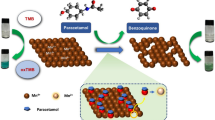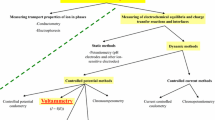Abstract
A rapid, simple, and highly sensitive electroanalytical method was developed for the first time for the detection of ultra-trace amounts of nilotinib in sodium lauryl sulphate media. The electrochemical behavior of nilotinib was investigated on a glassy carbon electrode in the absence and presence of sodium lauryl sulphate media by cyclic voltammetry and adsorptive stripping voltammetric methods. The cyclic voltammograms proved that the electrochemical behavior of nilotinib showed irreversible and diffusion–adsorption-controlled oxidation processes in 0.1 M H2SO4. The effect of surfactant concentration on the first and second peaks of nilotinib was examined. Depending on whether the surfactants had a monomer or monolayer hemimicelle structure, they were attracted to amine moieties at related points in the nilotinib structure through the electrostatic interaction. The sensitivity of the method was markedly enhanced in the presence of surfactants using adsorptive stripping square-wave voltammetry. Under optimum conditions, nilotinib was determined in a concentration range of 2.0 × 10−8 to 2.0 × 10−6 mol L−1, with a limit of detection of 6.33 × 10−9 mol L−1 in 0.1 M H2SO4 containing 2.0 × 10−7 mol L−1 sodium lauryl sulphate. The proposed method can be applied for the sensitive determination of nilotinib in biological samples.

Graphical abstract






Similar content being viewed by others
References
DeRemer DL, Ustun C, Natarajan K. Nilotinib: a second-generation tyrosine kinase inhibitor for the treatment of chronic myelogenous leukemia. Clin Ther. 2008;30:1956–75. https://doi.org/10.1016/j.clinthera.2008.11.014.
(No Title). https://www.ema.europa.eu/en/documents/scientific-discussion/tasigna-epar-scientific-discussion_en.pdf. Accessed 8 Apr 2020.
Miura M, Takahashi N, Sawada KI. High-performance liquid chromatography with solid-phase extraction for the quantitative determination of nilotinib in human plasma. Biomed Chromatogr. 2010;24:789–93. https://doi.org/10.1002/bmc.1364.
Dziadosz M, Wagner MC, Lipka DB, Fischer T, Bartels H. High-performance liquid chromatography with ultraviolet detection and protein precipitation as a way of quantitative determination of nilotinib with and without internal standard. J Liq Chromatogr Relat Technol. 2012;35:2503–10. https://doi.org/10.1080/10826076.2011.636469.
Pursche S, Ottmann OG, Ehninger G, Schleyer E. High-performance liquid chromatography method with ultraviolet detection for the quantification of the BCR-ABL inhibitor nilotinib (AMN107) in plasma, urine, culture medium and cell preparations. J Chromatogr B Anal Technol Biomed Life Sci. 2007;852:208–16. https://doi.org/10.1016/j.jchromb.2007.01.019.
Parise RA, Egorin MJ, Christner SM, Shah DD, Zhou W, Beumer JH. A high-performance liquid chromatography-mass spectrometry assay for quantitation of the tyrosine kinase inhibitor nilotinib in human plasma and serum. J Chromatogr B Anal Technol Biomed Life Sci. 2009;877:1894–900. https://doi.org/10.1016/j.jchromb.2009.05.034.
Dogan-Topal B, Bozal-Palabiyik B, Ozkan SA, Uslu B. Electrochemical oxidation mechanism of anticancer drug Nilotinib. Rev Roum Chim. 2015;60:467–75.
Talay Pınar P, Yardım Y, Şentürk Z. Electrochemical oxidation of ranitidine at poly(dopamine) modified carbon paste electrode: its voltammetric determination in pharmaceutical and biological samples based on the enhancement effect of anionic surfactant. Sensors Actuators B Chem. 2018;273:1463–73. https://doi.org/10.1016/j.snb.2018.07.068.
Zhu M, Li R, Lai M, Ye H, Long N, Ye J, et al. Copper nanoparticles incorporating a cationic surfactant-graphene modified carbon paste electrode for the simultaneous determination of gatifloxacin and pefloxacin. J Electroanal Chem. 2020;857. https://doi.org/10.1016/j.jelechem.2019.113730.
Fekry AM, Shehata M, Azab SM, Walcarius A. Voltammetric detection of caffeine in pharmacological and beverages samples based on simple nano- co (II, III) oxide modified carbon paste electrode in aqueous and micellar media. Sensors Actuators B Chem. 2020;302:127172. https://doi.org/10.1016/j.snb.2019.127172.
Allahverdiyeva S, Talay Pınar P, Keskin E, Yunusoğlu O, Yardım Y, Şentürk Z. Adsorptive stripping voltammetric determination of higenamine on a boron-doped diamond electrode improved by the use of an anionic surfactant. Sensors Actuators B Chem. 2020;303. https://doi.org/10.1016/j.snb.2019.127174.
Rocha LR, de Cássica Mendonça J, Boareto Capelari T, Antigo Medeiros R, Teixeira Tarley CR. Development of a reliable and selective voltammetric method for determination of designer drug 1-(3-chlorophenyl)piperazine (mCPP) using boron-doped diamond electrode and exploiting surfactant-mediated measurements. Sensors Actuators B Chem. 2020;310:127812. https://doi.org/10.1016/j.snb.2020.127812.
Meng X, Xu Z, Wang M, Yin H, Ai S. Direct determination of 5-methylcytosine based on electrochemical activation of surfactant functionalized graphene modified pyrolytic graphite electrode. Electrochim Acta. 2013;95:200–4. https://doi.org/10.1016/j.electacta.2013.02.050.
Teradal NL, Kalanur SS, Prashanth SN, Seetharamappa J. Electrochemical investigations of an anticancer drug in the presence of sodium dodecyl sulfate as an enhancing agent at carbon paste electrode. J Appl Electrochem. 2012;42:917–23. https://doi.org/10.1007/s10800-012-0473-6.
Ozcelikay G, Dogan-Topal B, Ozkan SA. An electrochemical sensor based on silver nanoparticles-Benzalkonium chloride for the Voltammetric determination of antiviral drug Tenofovir. Electroanalysis. 2018;30:943–54. https://doi.org/10.1002/elan.201700753.
Wołowicz A, Staszak K. Study of surface properties of aqueous solutions of sodium dodecyl sulfate in the presence of hydrochloric acid and heavy metal ions. J Mol Liq. 2020;299:112170. https://doi.org/10.1016/j.molliq.2019.112170.
Compton RG, Banks CE. Understanding voltammetry. 2nd ed: Imperial College Press; 2010.
Gosser DK (1993) Cyclic voltammetry : simulation and analysis of reaction mechanisms. VCH.
Ermer J, Miller JHM (2005) Method validation in pharmaceutical analysis : a guide to best practice. Wiley-VCH.
Ozkan SA, Kauffmann J-M, Zuman P (2015) Electroanalytical Method Validationmethod validation in Pharmaceutical Analysis and Their Applications. pp. 235–266.
NAKAMURA H, SANO A, MATSUURA K. Determination of critical micelle concentration of anionic surfactants by capillary electrophoresis using 2-Naphthalenemethanol as a marker for micelle formation. Anal Sci. 1998;14:379–82. https://doi.org/10.2116/analsci.14.379.
Lebard DN, Levine BG, DeVane R, Shinoda W, Klein ML. Premicelles and monomer exchange in aqueous surfactant solutions above and below the critical micelle concentration. Chem Phys Lett. 2012;522:38–42. https://doi.org/10.1016/j.cplett.2011.11.075.
Bard AJ, Faulkner LR (2001) Electrochemical methods : fundamentals and applications. Wiley.
Nicholson RS, Shain I. Theory of stationary electrode polarography. Single scan and cyclic methods applied to reversible, irreversible, and kinetic systems. Anal Chem. 1964;36:706–23. https://doi.org/10.1021/ac60210a007.
Author information
Authors and Affiliations
Corresponding authors
Ethics declarations
Conflict of interest
The authors declare that there is no conflict of interest.
Additional information
Publisher’s note
Springer Nature remains neutral with regard to jurisdictional claims in published maps and institutional affiliations.
Electronic supplementary material
ESM 1
(PDF 751 kb)
Rights and permissions
About this article
Cite this article
Sener, C.E., Dogan Topal, B. & Ozkan, S.A. Effect of monomer structure of anionic surfactant on voltammetric signals of an anticancer drug: rapid, simple, and sensitive electroanalysis of nilotinib in biological samples. Anal Bioanal Chem 412, 8073–8081 (2020). https://doi.org/10.1007/s00216-020-02934-9
Received:
Revised:
Accepted:
Published:
Issue Date:
DOI: https://doi.org/10.1007/s00216-020-02934-9




